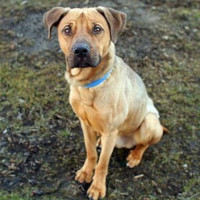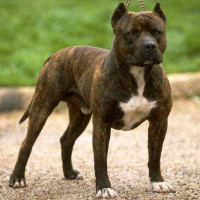 |
Shepherd Pit |
|
He is not recognized by the F.C.I. |
Origin |
Germany <> U.S.A. -> U.S.A. | |
Translation |
Francis Vandersteen |
A brief presentation of the Shepherd Pit |
| The Shepherd Pit is a hybrid between the German Shepherd and the American Pit Bull Terrier, or Pit Bull for short. It's a medium to large breed that tends to have the appearance of a larger Pit Bull with the color of the German Shepherd. Although both the Pit Bull and the German Shepherd have a bad reputation for being aggressive and difficult to handle, the Shepherd Pit is a wonderful breed when in the hands of the right owner. They are hard-working, intelligent, loyal, protective and affectionate. They're eager to please and love spending time with their family. It's important to remember that neither parent is particularly comfortable with children or other animals, so we must assume that the Shepherd Pit will be sensitive in these areas too. Despite this, with early socialization and careful training, the Shepherd Pit can make a wonderful dog for those looking for a guardian and a best friend. |
History of the Shepherd Pit |
| The Shepherd Pit was created in the U.S.A. in the early 2000s. Apart from that, however, we don't know much about why it was created and for what purpose. We can assume, based on its parent breeds, that the Shepherd Pit was created to have the intelligence and loyalty of the German Shepherd, with the fearlessness and power of the Pit Bull. Although both breeds unfortunately have a negative reputation, there are many truly excellent things about them that contribute to the creation of the Shepherd Pit. |
A little of the German Shepherd |
||
| The German Shepherd has been used for generations as a police dog and loyal companion. Originating in Germany around the 19th century and created specifically for its intelligence, good looks and versatile abilities, the German Shepherd has always been a fan favorite. The first dog of this breed to arrive in America was brought over around 1906, and a few years later, in 1912, the German Shepherd was accepted by the American Kennel Club as an official breed. His popularity continued to grow, and he enjoyed the love of people everywhere as he lived his life helping people and showing off his skills. This popularity took a hit during the First World War, however, when the breed was associated with a bad thing because of its ties to Germany. Despite the criticism, the German Shepherd continued to serve humanity, helping in the war as messengers, scouts and more. After the war, the talented German Shepherd made his way to the big screen and, thanks to this method, his popularity rose again. American audiences loved the brave, beautiful dogs that starred in some of their favorite films, because they lifted their spirits and put smiles on their faces. As a result, the German Shepherd regained popularity and became the most popular breed for some time. Since then, German Shepherds have been used as show animals, working animals and loyal companions for people all over the world. | ||
 |
||
| Standard of the German Shepherd |
A little of the American Pit Bull Terrier |
| The American Pit Bull Terrier, or Pit Bull, was originally created for a rather unfortunate reason. A combination of the Bulldog and Terrier breeds, the Pit Bull was an aggressive, fearless dog that people loved to use for dog fighting. This was a very popular event in America at a time when there was no television or video games to entertain people, so dog fighting was commonplace in the country. Fortunately, there were people who understood the Pit Bull's usefulness. It was used on farms for families who needed a good ratter and a loyal companion. The breed helped fight off dangerous creatures such as wild boar and bears, while also protecting their families from human threats. Pit Bulls were, and still are, known for getting on well with people, provided they are properly bred and socialized. They have an affectionate, loyal nature that's hard to ignore. Their loyal nature even led to them being used as representations of the United States on posters during the First World War and, to boost morale, they were used in comic strips such as “Buster Brown”. While the American Kennel Club does not recognize the Pit Bull as an official breed due to its unfortunate history, the United Kennel Club has registered the breed since 1898. Despite its history and original purpose, the Pit Bull is truly a wonderful dog if given the chance to show the world its best side. |
 |
| Presentation of the American Pit Bull Terrier |
Appearance of the Shepherd Pit |
| The Shepherd Pit can come in a number of different colors and tends to resemble a larger Pit Bull, with either a classic short muzzle or a longer one like the German Shepherd. The ears are erect on the head and have that well-known fold at the tip that is easily recognizable as an American Pit Bull Terrier trait. The coat tends to be short and close to the body like that of the Pit, but has a greater variety of colors thanks to the German Shepherd's contribution. This breed has large, round eyes that can be dark brown, light or amber in color, always reflecting its intelligence. With its long tail, strong body and robust head, the Shepherd Pit is an impressive combination of many amazing traits from both the German Shepherd and the Pit Bull. Due to its shorter coat, the Shepherd Pit tends to prefer warmer climates and sheds a moderate amount throughout the year. |
Temperament of the Shepherd Pit |
| As the Shepherd Pit has two parent breeds well known for their fearless and highly protective nature, it's important to bear in mind that this hybrid breed is not for everyone. The naturally aggressive nature that follows the German Shepherd and Pit Bull is necessary because of the tasks for which they were created and, if raised correctly, does not become a problem in everyday life. However, because of this nature, the German Shepherd must have an experienced owner who knows how to train and handle many different canine situations, such as correct interactions in dog parks, walks with other humans and dogs, as well as excellent training sessions that help improve overall manners. Despite this, the Shepherd Pit is a very affectionate breed and loyal to its family members. They love to play and have some sort of task assigned to them. Although not very noisy, it will bark if necessary, making it an excellent choice as a quiet watchdog. When this breed is around children, it's best to always supervise and practice early socialization to ensure the dog is accustomed to such interactions from an early age. |
Needs and activities of the Shepherd Pit |
| The Shepherd Pit is a very active breed, requiring several outdoor play and training sessions a day. Training is particularly important for this breed, as it needs mental stimulation to avoid boredom and improve its social interactions. Other activities that can be enjoyed with the Shepherd Pit include long jogs and walks, biking, hiking, agility training and yard games. By spending a lot of time with the Shepherd Pit, you'll not only bond with him and tire him out, but you'll also ensure that he's an excellent dog for your loved ones and others who may enter his space. |
Maintenance of the Shepherd Pit |
| Because of its short coat and moderate shedding, the Shepherd Pit is considered low to medium maintenance. Brushing a few times a month with a long-haired brush will be more than enough to keep its coat clean and beautiful. If dog hair bothers you a lot around the house, you may need to brush the Shepherd Pit a little more often, perhaps three times a week, to limit shedding. Otherwise, his short coat is always tangle-free and easy to clean if he shakes himself. Bathing is also rarely necessary, as the Shepherd Pit doesn't have a bad dog smell. He may need a bath sooner if he gets into something he shouldn't, but otherwise, this dog doesn't need much water. Just be sure to clean his ears often to check for debris, and trim his nails every two weeks to keep his paws healthy. This routine is simple and easy to carry out, so if you're looking for a dog that's easy to care for, the Shepherd Pit may be the one for you. |






 English (United Kingdom)
English (United Kingdom)